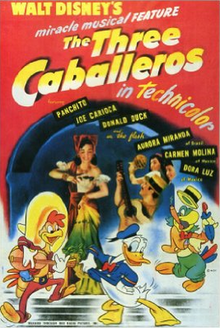 February 3, 1945 saw the release of The Three Caballeros, which frames Donald Duck opening birthday
gifts from his Latin American friends against a series of segments. The film
was the second one produced as a good will message for South America and stars Clarence
Nash, Jose Oliveira, and Joaquin Garay.
February 3, 1945 saw the release of The Three Caballeros, which frames Donald Duck opening birthday
gifts from his Latin American friends against a series of segments. The film
was the second one produced as a good will message for South America and stars Clarence
Nash, Jose Oliveira, and Joaquin Garay.
The film opens on Donald Duck receiving three presents. The
first is a film projector that shows him a documentary about birds. In the
documentary, he learns about the Aracuan Bird who proceeds to make several appearances
throughout the film.
Next, Donald is given a book by Jose Carioca, which tells of
Bahia, one of Brazil’s 26 states. Jose shrinks them both down so they can enter
the book and meet with several of the locals. They dance the samba and Donald
ends up infatuated with one of the girls. They leave the book and Donald finds
he is too small to pen the third present, so Jose shows him how to use magic to
turn himself to proper size. Upon opening the present, the two meet Panchito
Pistoles and the trio take the name of the Three Caballeros and have a short
celebration. Panchito presents Donald with a piñata and tells him of the
tradition behind it. He breaks it open and ends the celebration by being fired
away by firecrackers in the shape of a bull.
The frame story is broken up by seven segments:
The Cold-Blooded Penguin involves a penguin named Pablo who
is fed up with the cold South Pole and leaves for warmer climates.
The Flying Gauchito features a boy from Argentina and his
winged donkey, Burrito.
Bahia, which is a pop-up book trip through the state.
Los Posadas, which is a story told by Panchito of a group of
Mexican children celebrating Christmas by re-enacting the journey of Mary and
Joseph.
Mexico: Patzcuaro, Veracruz, and Acapulco, where Panchito
gives Donald and Jose a tour of Mexico on a flying sarape.
You Belong to My Heart over the skies of Mexico City as
Donlald falls in love with singer Dora Luz.
Donald’s Surreal Reverie, where Donald is kissed and goes
into a Disney Acid Sequence and dances with Carmen Molina.
This is what Saludos
Amigos should have been. It’s a coherent frame with sequences that make
sense. And not only do the sequences have a sense of belonging, the overarching
story is also fun to watch. Also, the running gag of the Aracuan Bird never got
old, which is probably why he appeared in a couple more shorts as time went on.
Unfortunately though, most of the music isn’t very
memorable. Only one song really stands out, and it’s the title song which also
features some funny gags.
Final Call: a story with shorts that belong and a frame that
doesn’t feel forced. It’s not going to make the Edge of Satisfaction, but it
will make #4.
No comments:
Post a Comment